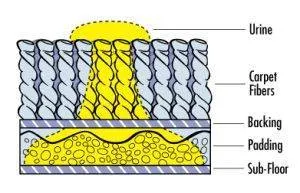How To Eliminate Urine Smell
If you’ve ever wondered how to get rid of pet urine smell in your home or how to get rid of dog urine from the carpet, then you’re not alone—not by a long shot. Here at Brooke’s Chem-Dry, we have thousands of people ask us the same questions every year.
To try to help solve this problem, we’ve put together a comprehensive guide to removing unpleasant pet urine odors and stains. If you’re already prepared to dive in and get the mess cleaned up, though, we’ve got you covered.
Just select one of the options below to let us know whether you’re looking for a cleaning solution so you can clean up a smaller mess yourself or whether it’s a bigger situation that requires some professional care.
Call Today: 785-760-8000
Step #1: Diagnose the Problem
If not treated properly, the odor from pet accidents can travel through the entire home and impact your health and your happiness. The smell emitted from an accident area also often leads to repeat incidents in the same area until it is properly eliminated.
The first thing to do when determining how to get the dog pee smell out of the carpet (or cat pee smell—we don’t discriminate!) is to locate the source of the smell. Once you’ve found the stained area(s) ask yourself the following questions:
How long has the stain or odor been there?
Is it still wet, or has the stain set in?
What type of material is the stained surface made of?
Carpet?
Upholstery?
Wood?
How large is the area that needs to be treated?
Have you verified that this is the only problem area?
Of course, most of these questions only work under the assumption that you know where the odor is coming from.
If you cannot find the source of the urine smell, then your best option is to contact a professional cleaning technician. At Chem-Dry, we use black lights to quickly find any areas in your home that need to be treated.
The Science Behind Black Lights and Urine
How exactly does a black light help us to find the problem area? Urine—and cat urine more than most—contains a substance called phosphorus. When it’s in the presence of oxygen, phosphorus will glow a yellowish green.
The phosphorus absorbs energy and releases it in the form of visible light. (This is true whether it is under a black light or not.)
Usually, this glow is rather dim, but a black light provides additional energy, which makes the light much brighter and easier to see. Under a black light, any areas that have been exposed to urine will glow.
Step #2: Remove the stain or odor
Once you’ve located all the areas that need to be cleaned, it’s time to get rid of the stain or odor. Pet urine leaves an unsightly blemish on your carpet, often accompanied by an unpleasant odor, but it doesn’t stop there.
It penetrates the fibers and contaminates, not only the carpet, but the floor underneath, as illustrated in this diagram.
Consequently, some carpet stains can require specialized cleaning, not just a simple cleaning, and treatment. As time passes without treating the affected area, the urine penetrates deeper into the floors, into the walls, and even into your home’s framework and foundation.
As your pet’s urine dries, the liquid portion of the stain evaporates; however, the remaining crystals become even more concentrated, leading to a stronger smell.
To get rid of pet urine smell, you’ll need something a step beyond just a simple cleaning.
TIPS: A Few Words of Warning Before You Begin
When you are removing a pet stain, here are some practices you should avoid. Here are some tips to help you to avoid making the situation even worse:
TIP #1: Don’t use a steam cleaner.
While a steam cleaner might seem like just the tool to get a deep clean for a stubborn stain, it’s quite the opposite. When you use a steam cleaner on a pet stain, the heat can actually make the stain even more difficult, or even impossible, to remove.
Just as the name suggests, steam cleaners use very hot water as they clean. The heat from the steam cleaner can actually cause the stain and odor to set, making them essentially permanent.
TIP #2: Avoid using strong-smelling chemicals—especially ammonia.
When you are cleaning up a pet’s accident, be very careful about which products you use. Strong-smelling cleaners—particularly ammonia and vinegar—can turn a single accident into a recurring problem. I have seen people try vinegar and baking soda, separately and together for the most part it just created a larger mess.
When pet urine degrades, bacteria break it down into uric acid, uric salts, etc. Eventually, it converts into ammonia. Your pets are creatures of habit, and they often mark a specific spot in which to do their business.
To your pets, the smell of ammonia is a signal to reinforce that scent, so using ammonia is an invitation for them to mark the same spot.
TIP #3: Stay away from enzyme-based products
If you take a look at Chem-Dry’s competitors, you’ll notice that most of them use some sort of enzyme-based product to remove pet urine odors, most of which are virtually identical to the same products you can buy over the counter.
There are a few problems with enzyme-based products, though. In order for an enzyme product to be effective, it needs to stay in contact with the source for several hours. Not just stay in contact but also stay wet. This requires some constant watching and frequent re-application. Enzymes are also fragile and can be killed easily, so even after leaving the cleaner on the stain for hours, it may not have any noticeable effect.
Initial Cleanup
When you notice your pet has had an accident on your carpet or floor, the very first step to take is to gather paper towels and blot them. Try to soak up as much of the urine as possible to keep the stain from spreading and soaking in further. Not only will this help you to keep the area that needs to be treated small, but it will make it easier for the odor remover to do its job later.
Once you have cleaned up the initial mess, take a closer look and identify just how big the problem area that will require deeper cleaning is.
For Smaller Areas and Recent Stains
If the mess is small and hasn’t had the chance to set too deeply, we recommend using our Pet Odor Remover. This is a bio-enzymatic odor eliminator. It works well on fresh urine. The downside of bio-enzymatic products is they are made for fresh urine and only work when you follow the directions to the tee. Even then they aren’t always effective.
It is designed to lift fresh odors from your carpet and neutralize them without the use of harsh solvents or bleaches that could damage your carpet or leave dirt-attracting residues. It’s also safe to use around pets and children.
For Large Pee Stains, or Particularly Pungent Odors
If the stain covers a wide area, has had time to set in, or smells particularly strong, you should consult with one of Chem-Dry’s professional technicians. Once the urine has been given a chance to soak into the carpet, it can go deeper, permeating the padding and backing, or even into the subfloor.
There’s only so much that you can do with a spot clean, and Chem-Dry’s professionals are trained to do more than just remove the urine from the face of the carpet.
Chem-Dry has been doing this for a long time, and our technicians know very well how to get urine smell out of the carpet. They can go deeper and eliminate the bacteria that produce the odors.
When our technicians arrive, they will use special UV glasses and black lights to make sure that they don’t miss any spots that may not be visible to the naked eye.
It can take up to five years for dog urine smells or cat urine odor to decompose on its own, but our Pet Urine Removal Treatment (P.U.R.T.) accelerates the process and completes it in a fraction of that time, reducing what would take years to a matter of hours.
Our P.U.R.T. process has been tested and proven to remove 99.2% of bacteria from pet urine in carpets, as well as 99.9% of pet urine odors from carpets. It really is the best way to remove the pet urine smell.
Get Rid Of Pet Urine Smell – The P.U.R.T. Process
Once our technician has identified the stain and located any hidden spots that house odor-producing urine deposits, he will begin with a deep rinse.
Our patented Hot Carbonating Extraction process will penetrate deep into the carpet and remove the liquid, as well as any loose urine crystals that may have formed as the accident has begun to evaporate.
After completing the initial rinse, the technician will apply our P.U.R.T. odor removal product. This will go deep into your carpet’s fibers, the pad below, and even the floor underneath, providing a thorough cleaning in areas that most products and processes cannot reach.
As it dries over the next 24 to 36 hours, the P.U.R.T. solution will break down the substances that are actually causing the odors. Once each area has dried completely, the odor will be gone—and it won’t come back.
Step #3: Post-Treatment — Everyday Preventative Measures
Once the stain has been cleaned and the odor has been removed, how do you make sure that it doesn’t happen again? After all, as much as we love our dogs and cats, one of the things people often love most about their pets is how unpredictable they can be.
Unfortunately, that also means you need to be prepared for just about anything. To help you out, we’ve compiled a few tips to keep in mind to minimize the damage and likelihood of another incident.
Urine Odor
If your pet’s urine is particularly pungent, there are a few things to consider. To cut down on the smell, you might want to try reducing the amount of food you give your pet.
At the same time, give him more fresh water to drink. The pungency may come from him being dehydrated, leading to his urine being more concentrated.
Particularly during the warmer months, set out a bowl of ice cubes alongside your pet’s water bowl. This will provide additional hydration to make sure that he is getting plenty of fluids throughout the day.
If your pet continues to have strong-smelling urine, you should consult your veterinarian. Strong-smelling urine can be a symptom of a bladder infection or other medical condition, which you should have treated as soon as possible to keep your pet healthy and happy. Your vet can give you additional recommendations on how to make sure everything is going well.
Accident Prevention
They say that “an ounce of prevention is worth a point of cure,” and that’s certainly the case with pet accidents.
While it’s nice to know that there are ways to remove pet stains and odors, it’s even better if they never happen at all.
As we mentioned before, avoid cleaning products that contain ammonia. While it is a powerful cleaner, ammonia is also one of the components of your pet’s urine.
When you clean an area with ammonia, the smell is essentially an invitation to your pet to urinate in that spot.
Once the mess is cleaned up, you want to deter your pet from returning to that spot for a repeat of the accident. Pets strongly dislike eating in the same place they relieve themselves, so place small bowls of the food in the affected area. If your pet begins to associate that area with food, she will be less likely to change her habits.
Do whatever you can to make the problem area unattractive or inconvenient for your pet while making the appropriate bathroom area as attractive as possible.
If it is difficult for your pet to reach the problem spot, or if the spot becomes unappealing as a bathroom area, your pet will likely change her habits.
If your pet is having frequent accidents, check with your veterinarian to make sure that there isn’t an underlying medical issue. Accidents can be an indication that there is something wrong, especially if your dog or cat has no previous history of accidents.
The key to preventing pet accidents is to figure out exactly what is causing them. Why is your pet relieving himself in the wrong space?
Is there something deterring them from using the spot you would prefer they use for the bathroom? Once you have determined your pet’s motivation, it becomes significantly easier to fix the problem.
What if the problem continues?
If, after all your efforts, the problem persists, then you may need to look deeper into what may be causing the trouble. There could be a health issue, or there would be some outside factor that is causing your pet distress.
About different pets:
Remember that dogs and cats are different. While both types of animals can be a beloved part of the same household, they are physiologically different creatures. Because of that, there are some specifics to keep in mind when working with one or the other.


